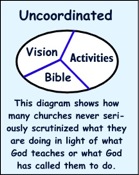
Book of ACTS
The Antioch Church: A Model for our Churches
The Bible Teacher's Commentary
Acts 13:1-3 (11:19-30)
Paul J. Bucknell
Purpose: A Bible exposition on Acts 13:1, A Developed Church, which gives us a remarkaeable picture of the mature leadership team there at the Antioch church. Why are our churches leadership function more as a pope than a leadership team? (Part 2 of 5).
Introduction Acts 13:1-3 | Leadership Acts 13:1 | Diversity Acts 13:1 |
God-seeking Acts 13:2 | Mission-minded Acts 13:3
Video Podcast on Acts 13:1-3
A) A Developed Church (Acts 13:1)
“Now there were at Antioch, in the church that was there, prophets and teachers: Barnabas, and Simeon who was called Niger, and Lucius of Cyrene, and Manaen who had been brought up with Herod the tetrarch, and Saul” (Acts 13:1).
The church of Antioch was surprisingly mature for its age. It was mature in a sense that most of our churches in our land that have had the holy scriptures have not yet reached this sense of maturity as seen in the team leadership. In this case the church in Antioch becomes a model for us.
Before we get into how that church is a model for us, let us first understand a little about this church. How did this church reach this point so quickly?
Transfer Membership
Many things happened in the church since that Pentecost when the Spirit of God flooded the church of God in Acts 2 around 36 AD. Many thousands had come to know the Lord. A strong leadership formed in Jerusalem and local communities quickly developed. Some like Philip and Steven were powerful advocates of the risen Lord to the church not only in Jerusalem but in other places that had not heard about the Lord Jesus.
During that same time, the church started jumping cultures just as Jesus commanded, though more from pressure than direct obedience.  The church did not plan this, but it is seen more as a deliberate push from the Holy Spirit such as when the men from Joppa came to Peter (Acts 10).
The church did not plan this, but it is seen more as a deliberate push from the Holy Spirit such as when the men from Joppa came to Peter (Acts 10).
The church in Jerusalem, which was the mother church with the apostles, faced a large crisis. Persecution set in. Again, if one looks from hindsight, this all seemed to be part of God’s plan. God used it to spread His Word around the world. Notice the backdrop of the Antioch church in Acts 11.
“So then those who were scattered because of the persecution that arose in connection with Stephen made their way to Phoenicia and Cyprus and Antioch, speaking the word to no one except to Jews alone. But there were some of them, men of Cyprus and Cyrene, who came to Antioch and began speaking to the Greeks also, preaching the Lord Jesus. And the hand of the Lord was with them, and a large number who believed turned to the Lord.
And the news about them reached the ears of the church at Jerusalem, and they sent Barnabas off to Antioch. Then when he had come and witnessed the grace of God, he rejoiced and began to encourage them all with resolute heart to remain true to the Lord; for he was a good man, and full of the Holy Spirit and of faith. And considerable numbers were brought to the Lord” (Acts 11:19-24).
 A Persecuted Church
A Persecuted Church
The church in Antioch was not a rich or traditional church but the gathering of persecuted Christians from Jerusalem. After Stephen was stoned, a great persecution arose against the believers. They were spread all about the east coast of the Mediterranean including the big city of Antioch in Syria (see map). Seleucia was the nearby harbor for the beautiful and prosperous city of Antioch. Antioch was a little over 200 miles to the north of Jerusalem and in a short time became the new center of outreach.
The Antioch church distinguished itself in several ways.
Shared Leadership
The first noticeable thing about this church is that there was not just a one pastor leadership in place. There were prophets and teachers including some significantly gifted individuals. Four significant leaders were mentioned but there were probably others less well known.
Many churches are still strongly affected by the overly structured Roman Catholic church or the modified Reformed churches which makes the church content with their one priest or pastor. A strong church, pictured in Ephesians 4:11-12, is characterized by a multi-gifted leaders in the church. The difference of the Antioch church is quite significant.
What is a prophet?My largest concern is that most churches have declared prophets to be remnants of the past. It appears that the absence of prophets and evangelists indicates a church that is not very sensitive to God and not boldly preaching God’s word to the world. |
I once attended a Baptist church which at first was what we traditionally expect. They had one pastor and deacons. They worked hard but finally became a church that more closely followed the Antioch church. They later were run by elders including the pastor. This is develop of a functional teacher/elder board is increasingly common, but most churches fall far short of even this.
A church content with their own paid pastor usually is focused on meeting their own needs. The pastor runs to and fro caring for the needs of the flock. This is good and proper, but it is lacking. The early church was just developing but from what I see from around the world, that an active and new church settles down into a more comfortable secure posture.
The leaders of a mature church are building up the church in such a way that the people of God are growing and being equipped. The result of this kind of leadership brings about a multi-faceted leadership. This church had both teachers and prophets.
The one designated pastor builds up other gifted men, sometimes more than himself. They work together. They together focus on training and serving others. There is an outward perspective rather than an inward one. We should not have to raise the question, “Why don’t we have enough leaders?” We should focus on where we will assign this brother? A lack of momentum accelerates our tendency to be lazy, worldly and not involved.
Mature Leadership
Many churches which have mission programs still focus on themselves. Unless this church had many growing leaders, they probably could not afford to send off some of their best teachers on a mission trip. I do not think that they knew how long it would be before those sent away would return.
One large reason for this is that the Greeks (think Gentiles) were starting to be reached and several mission efforts took place starting in Antioch. And so in a little over ten years around 46 AD, this church became a major center of Christian outreach. Not every church needs to be a center. Usually the churches in more central parts of the world or a country become center churches. They greatly influence what happens later in that region. Whether it is a center does not matter as much as what kind of center it is!
Application
We need to ask, “What kind of church are we?” “What are we passing on to others?” What kind of leadership do we have? How does it help or hinder us? What is our vision? What is it that God wants to do through our lives?
More leaders for more holy work!
Watch who you copy!
Next -> B) A Diverse Church (Acts 13:1)
BFF -> Moving our generation's heart and mind closer to the Lord through the powerful truths of God!





